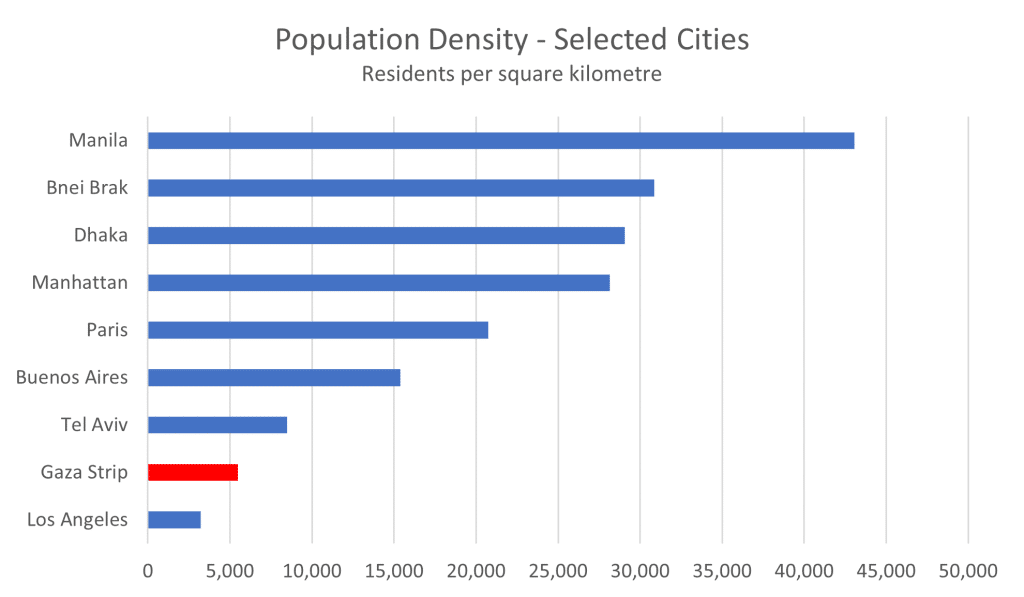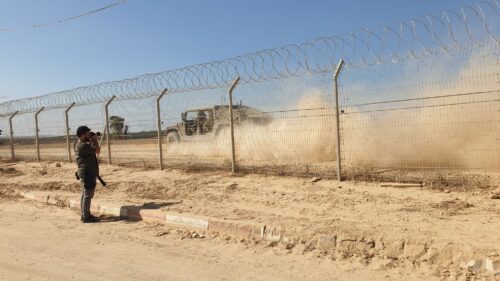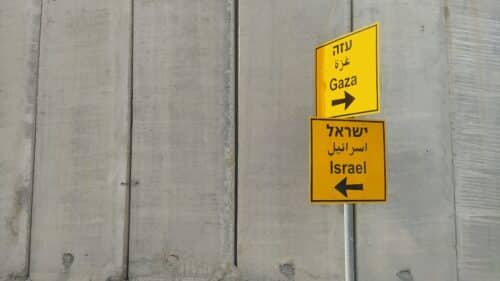A common claim in news reports, viral videos, and even in official statements by world leaders and public figures, is that the Gaza Strip is the most densely populated place in the world, or at least one of the densest. We set out to factcheck this claim.
Bottom line? Not true.
This would not be the first – or even the most commonly reiterated – fallacy propagated in regards to the Israeli-Palestinian conflict, yet for the sake of accuracy, one has to acknowledge the facts that shape the discussion on this claim. While the Gaza Strip is certainly a densely populated area, it does not even crack the top 100 most densely populated areas or cities in the world.
Population density is measured according to population size relative to the area of a given territory. In the Gaza Strip there are approximately 2 million residents, in an area that spans 365 square kilometres. Quick calculations peg Gaza’s population density at 5,479 people per square kilometre – roughly the density of London. Is London being presented as one of the most densely populated places on earth?
Zeroing in on the urban areas in the Gaza Strip, one certainly sees how it is home to a densely populated urban landscape, yet not irregular for the populated centres of the 21th century, which are characterized across the globe by major metropolises packed with residential buildings and commuters. Cities such as Gaza City, Khan Younis and Beit Lahia, while certainly dense, also stand back-to-back with large open-field agricultural spaces and beach promenades.
Now to the numbers: in 2017, Gaza City’s population was estimated at 590,481 by the Palestinian Bureau of Statistics, a city whose area spans over 45 square kilometers, which gives it a population density of 13,121 people per square kilometer – a common level of density, akin to metropolises such as Buenos Aires, wherein 15,372 people live within the same area. Is Buenos Aires being widely presented as a humanitarian crisis zone?
Khan Younis, being the second largest city in the Strip, had a population of 205,125 people that year, on an area of 54.56 square kilometers. That would attribute it with a population density of 3,759, not even getting it into the top 100 most densely populated areas on the planet.
Consider exceptionally dense areas such as Manila, the Philippines, with 43,064 people crammed into every square kilometre, or Dhaka, Bangladesh, with 29,069 people per square kilometre. These are major metropolitan giants whose avenues are jammed with commuters crowding their congested streets, contending with significant humanitarian issues, not the least of which is the lack of sufficient health services. Yet not one single UN security council meeting nor general assembly resolution ever referred to them as a people on the verge of a humanitarian disaster, or even the most densely populated areas on the planet – which they undoubtedly are.
Paris, France, is 4 times more densely populated than Gaza. So are Mumbai, India; Hoboken, NY, the United States. Bogota, Columbia, is 5 times more so. Manhattan’s population density stands at a staggering 28,154 residents per square kilometres, leaving Gaza very far behind.
Moreover, even the population density of all Israel’s 10 largest cities is far higher than that of Gaza, with cities like Bnei Brak overwhelmed by more than 26,368 people per square kilometre, the 5th most densely populated city in the world; Bat Yam has over 15,000, and Tel Aviv – over 8,500.
One should bear in mind that the Palestinian Bureau of Statistics is not known for its commitment to accuracy, and was caught more than once cooking the books. Population size is deliberately beefed up in the PBS reports as a means to put pressure on Israel to accept the “demographic demon” theory, that an oversized Palestinian population requires painful concessions on Israel’s part that necessitate security compromises. In an interview to the New York Times in 1997, Hassan Abu-Libdeh, Head of the Palestinian Bureau of Statistics, dubbed the census “civil Intifada”.
The Gaza Strip is certainly a densely populated place, yet it hardly stands out as an exceptional case of a dense urban metropolitan. With disinformation propagating at large regarding the conflict, accusing Israel of going after terrorist organizations that threaten its existence or dealing with security threats head-on is not an uncommon characteristic of the public discourse. While Hamas deliberately places its rockets and ammunition underneath civilian settings such as schools, mosques, and hospitals as evidently proven by multiple sources, Israel has been developing top-of-the-spear technologies such as precision missiles to target these terrorists, so that it may defend its own population while minimizing collateral damage, including civilian casualties. One has to bear these in mind in the spiral of heated public debate, and stick to facts even when they are uncomfortable for the desired narrative.







